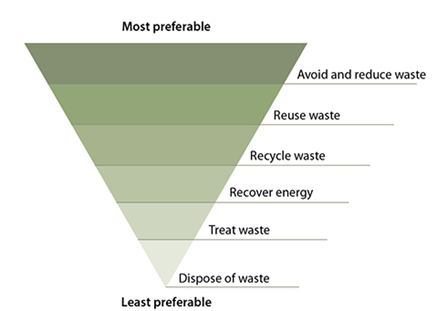Waste Management

Waste Management
Waste management represents all the activities and actions required to manage waste from its generation to its final disposal. This includes amongst other things collection, transport, treatment and disposal of waste together with monitoring and regulation.
The term normally relates to all kinds of waste, whether generated during the extraction of raw materials, the processing of raw materials into intermediate and final products, the consumption of final products, or other human activities, including municipal (residential, institutional, commercial), agricultural, and social (health care, household hazardous waste, sewage sludge). Waste management is intended to reduce adverse effects of waste to the health, the environment or aesthetics.
One of the most important thing for proper waste management is proper selection of waste. This includes selection of different types of waste and their disposal in containers intended for that particular type of waste. According current legislation paper shall be disposed at blue containers, glass at green, plastic at yellow, metal and WEEE at red containers. The colors for containers are defined according the legally binding acts for EU member states and EU candidate countries.
WASTE HIERARCHY

The waste hierarchy is a set of priorities for the efficient use of resources. The waste hierarchy is:
1. Avoidance including action to reduce the amount of waste generated by households, industry and all levels of government
2. Resource recovery including re-use, recycling, reprocessing and energy recovery, consistent with the most efficient use of the recovered resources
3. Disposal including management of all disposal options in the most environmentally responsible manner.
Avoiding and reducing waste
The highest priority, avoiding and reducing the generation of waste, encourages the community, industry and government to reduce the amount of virgin materials extracted and used. The goal is to maximize efficiency and avoid unnecessary consumption through behaviors such as:
- the fewest resources to produce
- avoiding disposable goods or single-use materials
- buying products that are recycled, recyclable, repairable, refillable, re-usable or biodegradable
- using leftover food rather than throwing it away.
Recovering resources
The second priority, resource recovery, maximizes options for re-use, recycling, reprocessing and energy recovery.
Where avoiding and reducing waste is not possible, the next most preferred option is to re-use the materials without further processing, avoiding the costs of energy and other resources required for recycling. For example, many household and industrial items can be repaired, re-used, sold or donated to charities. Re-use (without further processing) and recycling (processing waste materials to make the same or different products) keeps materials in the productive economy and benefits the environment by decreasing the need for new materials and waste absorption.
Where further recycling is not feasible, it may be possible to recover the energy from the material and feed that back into the economy where this is acceptable to the community Some materials may be inappropriate to re-use, recycle or recover for energy and instead require treatment to stabilize them and minimize their environmental or health impacts.
Treatment or disposal
Finally, the waste hierarchy recognizes that some types of waste, such as hazardous chemicals or asbestos, cannot be safely recycled and direct treatment or disposal is the most appropriate management option.
Types of waste
Waste can be classified into different waste streams including various types of materials that have different physical and chemical properties and therefore must be treated and disposed of in different ways. The major waste streams in the industries from both regions are given in the table below:
| TYPE OF WASTE | DEFINITION |
| “Waste” | shall mean any substance or object that the generator or the holder discards, intends to discard or is required to discard; |
| Hazardous waste | shall mean any waste that has one or more hazardous properties such as: explosive, reactive (oxidizing), flammable, irritant, corrosive, toxic, infectious, carcinogenic, mutagenic, toxic to reproduction, eco-toxic, and properties of toxic gasses release when getting in contact with water, air or acid, specified in accordance with the Law on waste, or other regulation, and listed and specifically designated as hazardous in the List of Wastes, including any waste that is mixed with hazardous waste |
| Non-hazardous waste | shall mean any waste which does not possess the properties of a hazardous waste |
| Inert waste | shall mean any waste that is resistant and that does not undergo any significant physical, chemical or biological transformations, does not dissolve, burn out or react otherwise physically or chemically, does not biodegrade, and the waste and its leachate do not affect another substance they come in contact with in a manner that could endanger the environment and human life and health |
| Municipal waste | shall mean non-hazardous waste generated by individuals in the households, as well as commercial waste |
| Commercial waste | shall mean any other waste generated by legal entities and individuals while performing commercial, industrial, trade, service, administrative and similar activities, which is similar to the waste from households in nature or composition |
| Industrial non-hazardous waste | shall mean any waste generated during production processes in industry and does not possess hazardous characteristics, while it differs from municipal waste in its features, composition and quantity |
| Biodegradable waste | shall mean any waste that can be decomposed through anaerobic (no oxygen present) or aerobic (oxygen present) decomposition processes |
| Waste oils | shall mean any mineral, synthetic or industrial oils in liquid or semi-liquid state that have become unfit for the use they had been originally intended, and in particular used oils for internal combustion engines, oils for gearbox, as well as oils for turbines and hydraulic oils |
| Batteries and accumulators | shall mean sources of electricity generated by direct transformation of the chemical energy, consisting of one or more primary cells that cannot be recharged or of secondary cells that can be recharged |
| Used batteries and accumulators | shall mean any battery and accumulator that cannot be used again and that is intended for processing or disposal |
| Waste electric and electronic device | shall mean any electric and electronic device which the generator and/or holder is discarding, intends to discard or is required to discard, including all parts and components which are integral parts of the device at the time of discarding |
| Packaging waste | shall mean any packaging or packaging material that the generator or holder is discarding, intends to discard or is required to discard, except for the residues from the production |
Definitions are given according to the Law on waste management, Law on batteries and accumulators and management of waste batteries and accumulators as well as Law on WEEE of Republic of Macedonia, which are in compliance with appropriate EU Directives. More information for national legislation is given under the section Materials/Other useful materials
Cross-border Partnership for Environmental Protection and Better Quality of Life (Waste EDU)




The web-site is co-funded by EU trough the INTERREG - IPA Cross-border Programme CCI 2014TC16I5CB006 Bulgaria- Macedonia. This web site has been produced with the assistance of the European Union. The contents of this web site are the sole responsibility of the Center for Climate Change- Gevgelija and can in no way be taken to reflect the views of the European Union, the participating countries and the Managing Authority.


 |
|  |
|